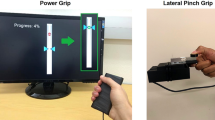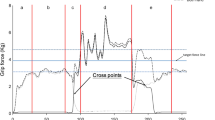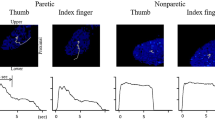Abstract
Many stroke survivors with severe impairment can grasp only with a power grip. Yet, little knowledge is available on altered power grip after stroke, other than reduced power grip strength. This study characterized stroke survivors’ static power grip during 100 and 50 % maximum grip. Each phalanx force angular deviation from the normal direction and its contribution to total normal force was compared for 11 stroke survivors and 11 age-matched controls. Muscle activities and skin coefficient of friction were additionally compared for another 20 stroke and 13 age-matched control subjects. The main finding was that stroke survivors gripped with a 34 % greater phalanx force angular deviation of 19° ± 2° compared to controls of 14° ± 1° (p < .05). Stroke survivors’ phalanx force angular deviation was closer to the 23° threshold of slippage between the phalanx and grip surface, which may explain increased likelihood of object dropping in stroke survivors. In addition, this altered phalanx force direction decreases normal grip force by tilting the force vector, indicating a partial role of phalanx force angular deviation in reduced grip strength post-stroke. Greater phalanx force angular deviation may biomechanically result from more severe underactivation of stroke survivors’ first dorsal interosseous and extensor digitorum communis muscles compared to their flexor digitorum superficialis or somatosensory deficit. While stroke survivors’ maximum power grip strength was approximately half of the controls, the distribution of their remaining strength over the fingers and phalanges did not differ, indicating evenly distributed grip force reduction over the entire hand.






Similar content being viewed by others
References
Akima H, Kubo K, Imai M, Kanehisa H, Suzuki Y, Gunji A et al (2001) Inactivity and muscle: effect of resistance training during bed rest on muscle size in the lower limb. Acta Physiol Scand 172:269–278
Amis AA (1987) Variation of finger forces in maximal isometric grasp tests on a range of cylinder diameters. J Biomed Eng 9:313–320
Barry BK, Carson RG (2004) The consequences of resistance training for movement control in older adults. J Gerontol A Biol Sci Med Sci 59:730–754
Basmajian J (1989) Biofeedback principles and practice for clinicians. Williams and Wilkins, Baltimore
Blennerhassett JM, Matyas TA, Carey LM (2007) Impaired discrimination of surface friction contributes to pinch grip deficit after stroke. Neurorehabil Neural Repair 21:263–272
Boissy P, Bourbonnais D, Carlotti MM, Gravel D, Arsenault BA (1999) Maximal grip force in chronic stroke subject and its relationship to global upper extremity function. Clin Rehabil 13:354–362
Buchholz B, Frederick LJ, Armstrong TJ (1988) An investigation of human palmar skin friction and the effects of materials, pinch force and moisture. Ergonomics 31:317–325
Carey LM (1995) Somatosensory loss after stroke. Crit Rev Phys Rehabil Med 7:51–91
Chae J, Bethoux F, Bohine T, Dobos L, Davis T, Friedl A (1998) Neuromuscular stimulation for upper extremity motor and functional recovery in acute hemiplegia. Stroke 29:975–979
Chao EY, Opgrande JD, Axmear FE (1976) Three-dimensional force analysis of finger joints in selected isometric hand functions. J Biomech 9:387–396
Cole KJ (1991) Grasp force control in older adults. J Mot Behav 23:251–258
Cole KJ (2006) Age-related directional bias of fingertip force. Exp Brain Res 175:285–291
Cooper R, Strand BH, Hardy R, Patel KV, Kuh D (2014) Physical capability in mid-life and survival over 13 years of follow-up: British birth cohort study. BMJ 348:g2219
Cruz EG, Waldinger HC, Kamper DG (2005) Kinetic and kinematic workspaces of the index finger following stroke. Brain 128:1112–1121
Dattola R, Girlanda P, Vita G, Santoro M, Roberto ML, Toscano A et al (1993) Muscle rearrangement in patients with hemiparesis after stroke: an electrophysiological and morphological study. Eur Neurol 33:109–114
Di Fabio RP, Badke MB (1991) Stance duration under sensory conflict conditions in patients with hemiplegia. Arch Phys Med Rehabil 72:292–295
Enders LR, Seo NJ (2011) Phalanx force magnitude and trajectory deviation increased during power grip with an increased coefficient of friction at the hand–object interface. J Biomech 44:1447–1453
Fugl-Meyer AR, Jaasko L, Leyman I, Olsson S, Steglind S (1975) The post-stroke hemiplegic patient. 1. A method for evaluation of physical performance. Scand J Rehabil Med 7:13–31
Gee MG, Tomlins P, Calver A, Darling RH, Rides M (2005) A new friction measurement system for the frictional component of touch. Wear 259:1437–1442
Gowland C, VanHullenaar S, Torresin W, Moreland J, Vanspall B, Barrecca S et al (1995) Chedoke–McMaster stroke assessment: development, validation and administration manual. Chedoke–McMaster Hospitals and McMaster University, Hamilton
Gray CS, French JM, Bates D, Cartlidge NE, James OF, Venables G (1990) Motor recovery following acute stroke. Age Ageing 19:179–184
Gurram R, Gouw GJ, Rakheja S (1993) Grip pressure distribution under static and dynamic loading. Exp Mech 33:169–173
Harms H, Reimnitz P, Bohner G, Werich T, Klingebiel R, Meisel C et al (2011) Influence of stroke localization on autonomic activation, immunodepression, and post-stroke infection. Cerebrovasc Dis 32:552–560
Hermsdorfer J, Hagl E, Nowak DA, Marquardt C (2003) Grip force control during object manipulation in cerebral stroke. Clin Neurophysiol 114:915–929
Hu XL, Tong KY, Li L (2007) The mechanomyography of persons after stroke during isometric voluntary contractions. J Electromyogr Kinesiol 17:473–483
Hwang K, Huan F, Kim DJ (2013) Muscle fibre types of the lumbrical, interossei, flexor, and extensor muscles moving the index finger. J Plast Surg Hand Surg 47:268–272
Johanson ME, Valero-Cuevas FJ, Hentz VR (2001) Activation patterns of the thumb muscles during stable and unstable pinch tasks. J Hand Surg 26:698–705
Kallman DA, Plato CC, Tobin JD (1990) The role of muscle loss in the age-related decline of grip strength: cross-sectional and longitudinal perspectives. J Gerontol 45:M82–M88
Kamper DG, Rymer WZ (2001) Impairment of voluntary control of finger motion following stroke: role of inappropriate muscle coactivation. Muscle Nerve 24:673–681
Kamper DG, Harvey RL, Suresh S, Rymer WZ (2003) Relative contributions of neural mechanisms versus muscle mechanics in promoting finger extension deficits following stroke. Muscle Nerve 28:309–318
Kinoshita H, Backstrom L, Flanagan JR, Johansson RS (1997) Tangential torque effects on the control of grip forces when holding objects with a precision grip. J Neurophysiol 78:1619–1630
Klitgaard H, Zhou M, Schiaffino S, Betto R, Salviati G, Saltin B (1990) Ageing alters the myosin heavy chain composition of single fibres from human skeletal muscle. Acta Physiol Scand 140:55–62
Kong Y-K, Lowe BD (2005) Optimal cylindrical handle diameter for grip force tasks. Int J Ind Ergon 35:495–507
Kutch JJ, Valero-Cuevas FJ (2011) Muscle redundancy does not imply robustness to muscle dysfunction. J Biomech 44:1264–1270
Laidlaw DH, Kornatz KW, Keen DA, Suzuki S, Enoka RM (1999) Strength training improves the steadiness of slow lengthening contractions performed by old adults. J Appl Physiol 87:1786–1795
Lang CE, Schieber MH (2004a) Human finger independence: limitations due to passive mechanical coupling versus active neuromuscular control. J Neurophysiol 92:2802–2810
Lang CE, Schieber MH (2004b) Reduced muscle selectivity during individuated finger movements in humans after damage to the motor cortex or corticospinal tract. J Neurophysiol 91:1722–1733
Latash ML, Scholz JP, Schoner G (2002) Motor control strategies revealed in the structure of motor variability. Exerc Sport Sci Rev 30:26–31
Lee SJ, Kong YK, Lowe BD, Song S (2009) Handle grip span for optimising finger-specific force capability as a function of hand size. Ergonomics 52:601–608
Lexell J (1995) Human aging, muscle mass, and fiber type composition. J Gerontol A Biol Sci Med Sci 50 Spec No: 11–16
Li ZM, Zatsiorsky VM, Latash ML (2000) Contribution of the extrinsic and intrinsic hand muscles to the moments in finger joints. Clin Biomech 15:203–211
Li ZM, Zatsiorsky VM, Latash ML (2001) The effect of finger extensor mechanism on the flexor force during isometric tasks. J Biomech 34:1097–1102
Long C, Conrad PW, Hall EA, Furler SL (1970) Intrinsic–extrinsic muscle control of the hand in power grip and precision handling. An electromyographic study. J Bone Joint Surg 52-A:853–867
MacKenzie CL, Iberall T (1994) The grasping hand. North Holland, Amsterdam
McDonnell MN, Hillier SL, Ridding MC, Miles TS (2006) Impairments in precision grip correlate with functional measures in adult hemiplegia. Clin Neurophysiol 117:1474–1480
Milner TE, Dhaliwal SS (2002) Activation of intrinsic and extrinsic finger muscles in relation to the fingertip force vector. Exp Brain Res 146:197–204
Nakayama H, Jorgensen HS, Raaschou HO, Olsen TS (1994) Recovery of upper extremity function in stroke patients: the Copenhagen Stroke Study. Arch Phys Med Rehabil 75:394–398
Niessen MH, Veeger DH, Koppe PA, Konijnenbelt MH, van Dieen J, Janssen TW (2008) Proprioception of the shoulder after stroke. Arch Phys Med Rehabil 89:333–338
Nowak DA, Hermsdorfer J, Glasauer S, Philipp J, Meyer L, Mai N (2001) The effects of digital anaesthesia on predictive grip force adjustments during vertical movements of a grasped object. Eur J Neurosci 14:756–762
Nowak DA, Hermsdorfer J, Topka H (2003) Deficits of predictive grip force control during object manipulation in acute stroke. J Neurol 250:850–860
Palmer E, Ashby P (1992) Corticospinal projections to upper limb motoneurones in humans. J Physiol 448:397–412
Parker VM, Wade DT, Langton Hewer R (1986) Loss of arm function after stroke: measurement, frequency, and recovery. Int Rehabil Med 8:69–73
Pazzaglia C, Caliandro P, Granata G, Tonali P, Padua L (2010) “Dropping objects”: a potential index of severe carpal tunnel syndrome. Neurol Sci 31:437–439
Radhakrishnan S, Nagaravindra M (1993) Analysis of hand forces in health and disease during maximum isometric grasping of cylinders. Biomech Med Biol Eng Comput 31:372–376
Roger VL, Go AS, Lloyd-Jones DM, Benjamin EJ, Berry JD, Borden WB et al (2012) Heart disease and stroke statistics-2012 update: a report from the American Heart Association. Circulation 125:e2–e220
Sainburg RL (2005) Handedness: differential specializations for control of trajectory and position. Exerc Sport Sci Rev 33:206–213
Seo NJ, Armstrong TJ, Ashton-Miller JA, Chaffin DB (2007) The effect of torque direction and cylindrical handle diameter on the coupling between the hand and a cylindrical handle. J Biomech 40:3236–3243
Seo NJ, Rymer WZ, Kamper DG (2010) Altered digit force direction during pinch grip following stroke. Exp Brain Res 202:891–901
Seo NJ, Fischer HW, Bogey RA, Rymer WZ, Kamper DG (2011) Use of visual force feedback to improve digit force direction during pinch grip in persons with stroke: a pilot study. Arch Phys Med Rehabil 92:24–30
Slota GP, Enders LR, Seo NJ (2014) Improvement of hand function using different surfaces and identification of difficult movement post stroke in the Box and Block Test. Appl Ergon 45:833–838
Tabachnick BG, Fidell LS (2007) Using multivariate statistics. Ally and Bacon, New York
Turton AJ, Butler SR (2001) Referred sensations following stroke. Neurocase 7:397–405
Turton A, Lemon RN (1999) The contribution of fast corticospinal input to the voluntary activation of proximal muscles in normal subjects and in stroke patients. Exp Brain Res 129:559–572
Valero-Cuevas FJ (2000) Predictive modulation of muscle coordination pattern magnitude scales fingertip force magnitude over the voluntary range. J Neurophysiol 83:1469–1479
Valero-Cuevas FJ, Towles JD, Hentz VR (2000) Quantification of fingertip force reduction in the forefinger following simulated paralysis of extensor and intrinsic muscles. J Biomech 33:1601–1609
Wang J, Sainburg RL (2007) The dominant and nondominant arms are specialized for stabilizing different features of task performance. Exp Brain Res 178:565–570
Zaaimi B, Edgley SA, Soteropoulos DS, Baker SN (2012) Changes in descending motor pathway connectivity after corticospinal tract lesion in macaque monkey. Brain 135:2277–2289
Zatsiorsky VM, Latash ML (2004) Prehension synergies. Exercise Sport Sci Rev 32:75–80
Acknowledgments
This study was supported by the American Heart Association Midwest Affiliate Predoctoral Fellowship 12PRE9320004, Grant-In-Aid award from the American Society of Biomechanics, University of Wisconsin-Milwaukee Research Growth Initiative, Mary E. Switzer Distinguished Fellowship from the National Institute of Disability and Rehabilitation Research, Grant Number H133F110005. However, those contents do not necessarily represent the policy of the Department of Education, and you should not assume endorsement by the Federal Government. Also, this project was supported by the National Center for Advancing Translational Sciences, National Institutes of Health, through Grant Number 8UL1TR000055. Its contents are solely the responsibility of the authors and do not necessarily represent the official views of the NIH. The authors thank Dr. Thomas Armstrong and Mr. Charles Woolley for their aid in developing the custom-made grip dynamometer. The authors also thank Mr. Jeffrey King for his editorial service.
Author information
Authors and Affiliations
Corresponding author
Rights and permissions
About this article
Cite this article
Enders, L.R., Seo, N.J. Altered phalanx force direction during power grip following stroke. Exp Brain Res 233, 1677–1688 (2015). https://doi.org/10.1007/s00221-015-4241-9
Received:
Accepted:
Published:
Issue Date:
DOI: https://doi.org/10.1007/s00221-015-4241-9




